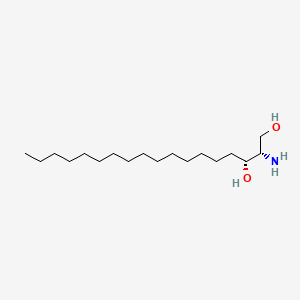Sphinganine
Sphinganine is a lipid of Sphingolipids (SP) class. Sphinganine is associated with abnormalities such as Sphingolipidoses, CLEFT LIP, CONGENITAL HEALED, Aortic aneurysm, familial thoracic 4, Morphologically altered structure and Atherosclerosis. The involved functions are known as Transcription, Genetic, Signal, Muscle Contraction, biological adaptation to stress and Gene Expression. Sphinganine often locates in Tissue membrane, Membrane, Protoplasm, Plasma membrane and Cytoplasmic. The associated genes with Sphinganine are SLC33A1 gene, HM13 gene, P4HTM gene, SPHK1 gene and SPHK2 gene. The related lipids are Sphingolipids, Phosphatidylserines, Sterols, Fatty Acids and inositolphosphorylceramide. The related experimental models are Mouse Model and Knock-out.
References related to lipids published in J. Biol. Chem.
| PMID | Journal | Published Date | Author | Title |
|---|---|---|---|---|
| 8626522 | J. Biol. Chem. | 1996 | Jarvis WD et al. | Induction of apoptosis and potentiation of ceramide-mediated cytotoxicity by sphingoid bases in human myeloid leukemia cells. |
| 7642524 | J. Biol. Chem. | 1995 | Smith ER and Merrill AH | Differential roles of de novo sphingolipid biosynthesis and turnover in the "burst" of free sphingosine and sphinganine, and their 1-phosphates and N-acyl-derivatives, that occurs upon changing the medium of cells in culture. |
| 9422785 | J. Biol. Chem. | 1998 | van Echten-Deckert G et al. | 1-Methylthiodihydroceramide, a novel analog of dihydroceramide, stimulates sphinganine degradation resulting in decreased de novo sphingolipid biosynthesis. |
| 9211877 | J. Biol. Chem. | 1997 | Oh CS et al. | ELO2 and ELO3, homologues of the Saccharomyces cerevisiae ELO1 gene, function in fatty acid elongation and are required for sphingolipid formation. |
| 9933590 | J. Biol. Chem. | 1999 | Alemany R et al. | Formyl peptide receptor signaling in HL-60 cells through sphingosine kinase. |
| 11278489 | J. Biol. Chem. | 2001 | El Bawab S et al. | Biochemical characterization of the reverse activity of rat brain ceramidase. A CoA-independent and fumonisin B1-insensitive ceramide synthase. |
| 12815058 | J. Biol. Chem. | 2003 | Johnson KR et al. | Role of human sphingosine-1-phosphate phosphatase 1 in the regulation of intra- and extracellular sphingosine-1-phosphate levels and cell viability. |
| 10722759 | J. Biol. Chem. | 2000 | Perry DK et al. | Serine palmitoyltransferase regulates de novo ceramide generation during etoposide-induced apoptosis. |
| 9804825 | J. Biol. Chem. | 1998 | Reggiori F and Conzelmann A | Biosynthesis of inositol phosphoceramides and remodeling of glycosylphosphatidylinositol anchors in Saccharomyces cerevisiae are mediated by different enzymes. |
| 14722105 | J. Biol. Chem. | 2004 | Deguchi H et al. | Sphingolipids as bioactive regulators of thrombin generation. |
| 10900202 | J. Biol. Chem. | 2000 | Mao C et al. | Cloning and characterization of a Saccharomyces cerevisiae alkaline ceramidase with specificity for dihydroceramide. |
| 22277656 | J. Biol. Chem. | 2012 | Montefusco DJ et al. | Sphingoid bases and the serine catabolic enzyme CHA1 define a novel feedforward/feedback mechanism in the response to serine availability. |
| 20628055 | J. Biol. Chem. | 2010 | Mao Z et al. | Alkaline ceramidase 2 (ACER2) and its product dihydrosphingosine mediate the cytotoxicity of N-(4-hydroxyphenyl)retinamide in tumor cells. |
| 20231281 | J. Biol. Chem. | 2010 | Han GS and Carman GM | Characterization of the human LPIN1-encoded phosphatidate phosphatase isoforms. |
| 20110363 | J. Biol. Chem. | 2010 | Pewzner-Jung Y et al. | A critical role for ceramide synthase 2 in liver homeostasis: I. alterations in lipid metabolic pathways. |
| 19357080 | J. Biol. Chem. | 2009 | Lahiri S et al. | Ceramide synthesis is modulated by the sphingosine analog FTY720 via a mixture of uncompetitive and noncompetitive inhibition in an Acyl-CoA chain length-dependent manner. |
| 16861742 | J. Biol. Chem. | 2006 | Denny PW et al. | The protozoan inositol phosphorylceramide synthase: a novel drug target that defines a new class of sphingolipid synthase. |
| 12411432 | J. Biol. Chem. | 2003 | Ogawa C et al. | Identification and characterization of a novel human sphingosine-1-phosphate phosphohydrolase, hSPP2. |
| 11056159 | J. Biol. Chem. | 2001 | Jenkins GM and Hannun YA | Role for de novo sphingoid base biosynthesis in the heat-induced transient cell cycle arrest of Saccharomyces cerevisiae. |
